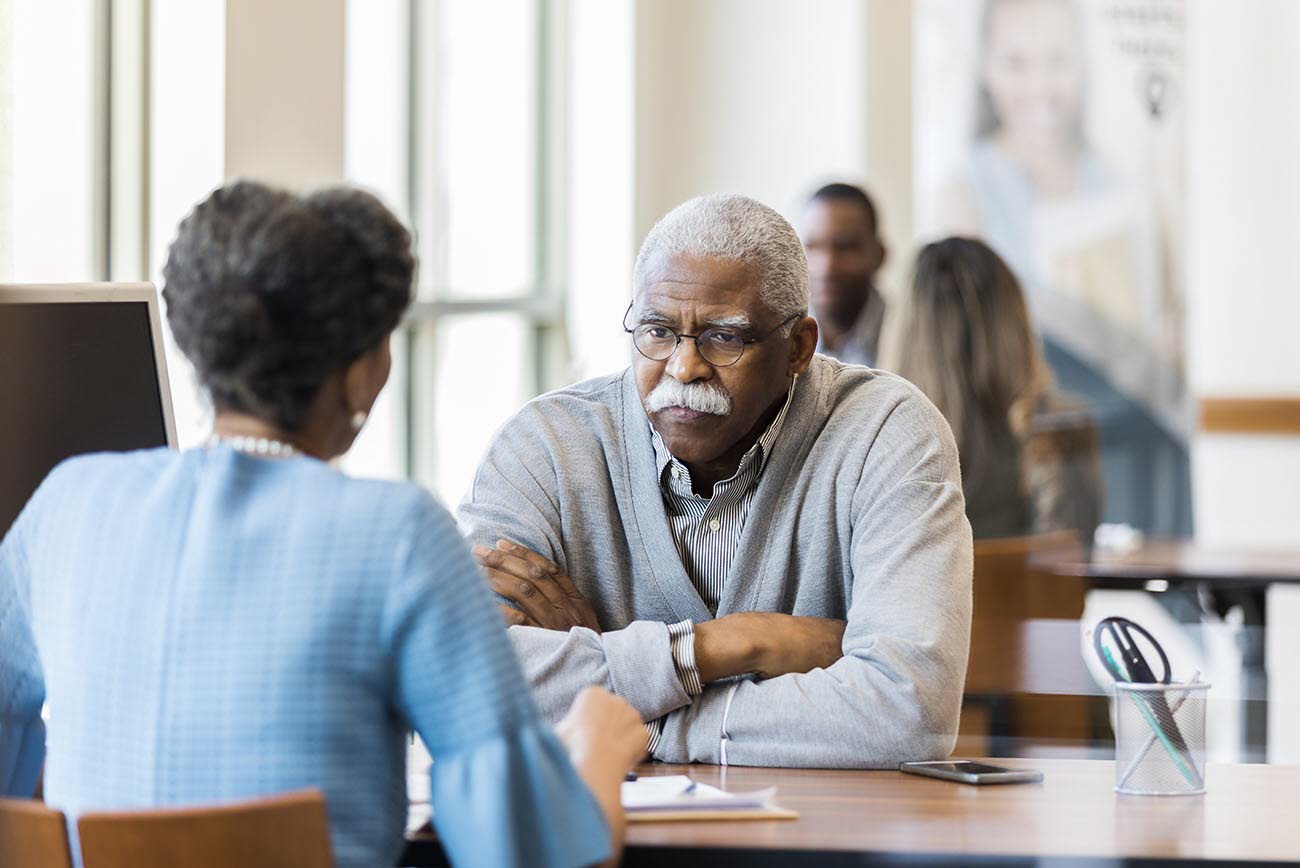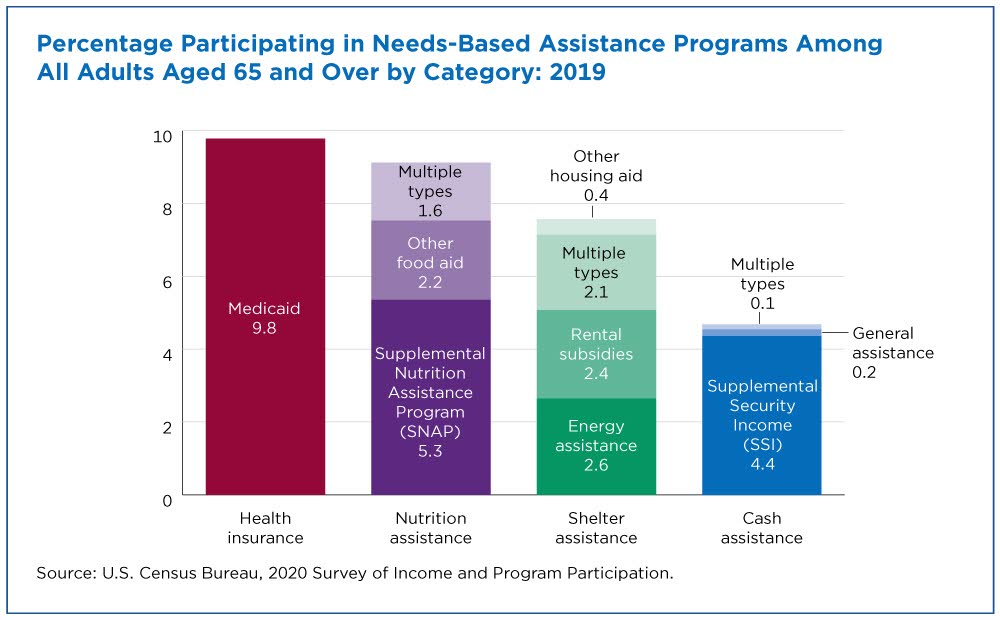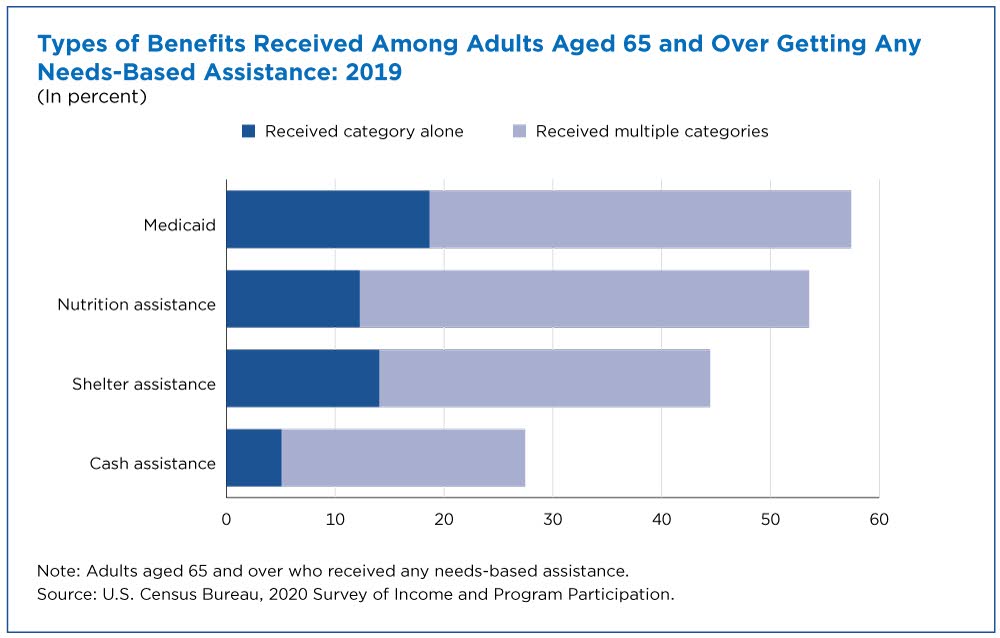One in Six Older Americans Received Needs-Based Assistance Even Before Pandemic
The vast majority of the nation’s 54 million adults ages 65 and over participate in Social Security (86%) and Medicare (93%) — social insurance programs designed to provide nearly-universal coverage of the older population.
But what happens when these social insurance benefits, along with retirement payments and savings, are not enough? What about those not eligible for Social Security or Medicare?
Approximately 9% participated in some form of nutrition assistance. SNAP was the most common type, either alone or in combination with other food aid.
They rely on needs-based assistance that support people with limited resources.
Prior to the COVID-19 pandemic, 1 in 6 older adults participated in a wide range of needs-based assistance programs, according to an analysis of recently released data from the Census Bureau’s Survey of Income and Program Participation (SIPP).
These numbers reveal the importance of the social safety net for economically vulnerable older adults, a need that may be amplified by the economic fallout of the pandemic.
These findings provide context about the experiences of adults ages 65 and over prior to the pandemic and will serve as a baseline for comparisons as additional data become available.
Benefit Sources
We examined formal government assistance, as well as assistance offered through nonprofits, churches and other local programs and found that older people piece together benefits from different assistance programs to meet basic needs.
These needs-based assistance programs fall into four categories:
- Health insurance through Medicaid.
- Nutrition assistance through the Supplemental Nutrition Assistance Program (SNAP) or other food assistance programs.
- Shelter assistance in the form of rental subsidies, energy assistance or other housing assistance programs.
- Cash assistance through the Supplemental Security Income (SSI) program or state- and county-level General Assistance (GA) programs.
Who Are the Older Americans Receiving Needs-Based Assistance?
Among older adults getting both Social Security and Medicare in 2019, 16% received needs-based assistance from one of the four categories examined, an indication that social insurance programs may not be enough for some older adults.
However, 9 million adults ages 65 and over did not receive both Social Security and Medicare, relying on only one or the other — or neither.
Almost a quarter of these adults participated in at least one type of needs-based assistance, highlighting the value of these benefits to those without the support of both Medicare and Social Security.
Among all adults ages 65 and over, those living alone, women and racial and ethnic minorities were more likely to rely on needs-based assistance:
- 27% of those living alone received at least one type of needs-based assistance compared to 13% of those who lived with other people.
- 35% of older non-Hispanic Black adults and 39% of older Hispanic adults received needs-based assistance from at least one category compared to 11% of older non-Hispanic White adults.
What Needs-Based Assistance Programs Are Older Americans Benefiting From?
Medicaid was the most common type of needs-based assistance received by those ages 65 and over. About 10% received Medicaid, either as a supplement or an alternative to Medicare.
Approximately 9% participated in some form of nutrition assistance. SNAP was the most common type, either alone or in combination with other food aid.
Nearly 8% of older adults received some type of shelter assistance and 5% received cash assistance from SSI or GA. (Temporary Assistance for Needy Families is not included because older Americans rarely have children under age 18.)
Some of these differences reflect varying availability of each needs-based assistance program.
For example, SNAP is available to all who meet eligibility requirements, but not everyone who is eligible applies. On the other hand, not all eligible applicants receive rental assistance because the number of rental subsidies available is limited.
Other programs, like Medicaid, have eligibility guidelines that vary by state.
Older Americans Piece Together Combinations of Needs-Based Assistance
Of the 1 in 6 older Americans who received needs-based assistance, half received just one type.
The other half received support from multiple types: 16% got three of the four types and 8% participated in programs across all four areas of needs-based assistance.
Among the older adults receiving any needs-based assistance, Medicaid was the most common with 57% participating, either alone or in combination with assistance from other categories.
Additionally, 54% received nutrition assistance, 44% received shelter assistance and 27% received cash assistance.
Needs-based assistance received from each category was at least two times more likely to be received in combination with other types of assistance than to be received alone.
Some older adults’ needs-based assistance packages may indicate difficulty affording health care, food, shelter and other necessities.
These findings highlight the value of SIPP for analyzing patterns of program participation in the United States. More information about the data can be found on the SIPP website.
Katherine G. Giefer and Michael D. King are survey statisticians in the Census Bureau’s Program Participation and Income Transfers Branch.
Story Ideas and Statistics
Stats for Stories
Stats for Stories
Facts for Features & Special Editions








